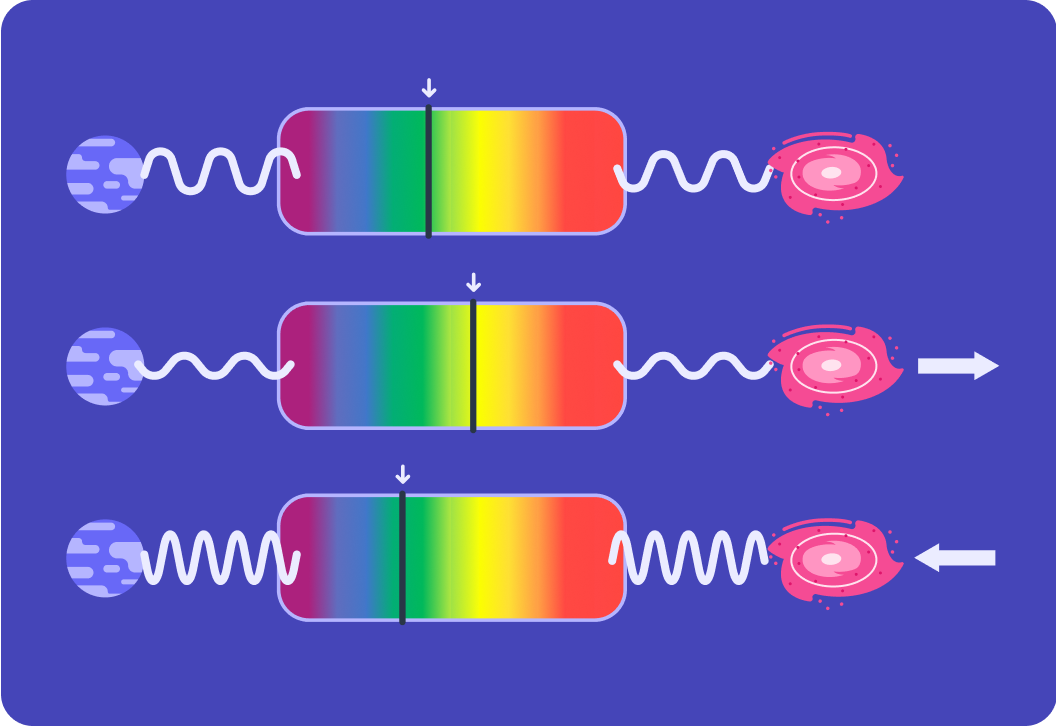YOU ARE LEARNING:
Evidence for the Big Bang Theory

Evidence for the Big Bang Theory
Discoveries such as the red-shift of distant galaxies and CMBR give us reasons to believe in the Big Bang theory.
According to scientists, before the Big Bang the Universe was condensed into an infinitely small, dense, and hot point - smaller than a pinhead. The only space that exists is the space the Big Bang created!
Scientists believe that the Big Bang happened around ___________ years ago.

The Big Bang theory states that around 13.8 billion years ago, there was a huge, hot explosion. What do scientists think happened after the Big Bang?

You can select multiple answers
Some scientists disagreed with the Big Bang theory and put forward an alternative theory. What is this alternative theory called?

Scientists who support the Steady State theory do not believe there was a 'big bang', but what belief about the Universe do the Big Bang theory and the Steady State theory have in common?

Red-shift is evidence to support the idea that the Universe is expanding. What is it that we study to find out about red-shift?

These images represent the spectrum of light we receive from distant galaxies.
The dark lines are caused by the absorption of light by certain atoms that make up a star or galaxy.

We usually know the absorption spectra of a star or galaxy should look like, as if it were not moving (like in the first image).
This means that we can tell if there has been a shift of the light along the spectrum.

In the second image, there has been...
A) a red-shift. B) a blue-shift. C) no shift.
Answer A, B or C.


Look at the wavelength of the light which has been red-shifted. How does the wavelength compare to those in the first image where there has been no red-shift? The wavelength has...


The light waves are stretched out when the galaxy is moving away from Earth, so the wavelength increases.
This is called a red-shift because the light is shifted towards the red part of the spectrum.

Red-shift shows that distant stars and galaxies are moving away from us, so this is evidence that the Universe is...

Red-shift supports the claim by both the Big Bang theory and the Steady State theory that the Universe is expanding. However, there is further evidence which supports only the Big Bang theory. That evidence, is the discovery of cosmic microwave background radiation.
Here we can see the electromagnetic spectrum, going from longest wavelength to shortest from right to left.
This is important for understanding how cosmic microwave background radiation supports the Big Bang theory.

Scientists knew that if the Universe began with a big bang, then high energy electromagnetic radiation should have been produced very soon after. Which type of electromagnetic radiation do you think was produced by the Big Bang?


In 1965, scientists detected microwaves coming from every direction in space. What conclusion do you think they came to?
A) The Big Bang created microwaves as well as gamma waves B) Gamma waves created by the Big Bang have stretched out as the Universe expanded. C) Microwaves have always been present in space.
Answer A, B or C.


If gamma radiation was created by the Big Bang, and the Universe has expanded, gamma waves will have stretched, creating longer and longer wavelengths.
The wavelengths have lengthened so much that the gamma radiation, at the time of the Big Bang, is now microwave radiation.

Why does the existence of cosmic microwave background radiation support the Big Bang Theory, but not the Steady State Theory? Pick the most correct option.

So red-shift and cosmic microwave background radiation are evidence for the Big Bang theory. But we find more evidence still from observing distant galaxies.
Where the Steady State theory states that the Universe has always been exactly as it is now, what does the Big Bang theory state?

When scientists and astronomers observe distant galaxies, they are actually looking back in time!
This is because it takes time for light to reach Earth.
The Sun's light takes 8.3 minutes to reach Earth, so when we look at the Sun, we see it as it looked 8.3 minutes ago. Light from Andromeda (our closest neighbouring galaxy) takes 2.5 million years to reach Earth, so scientists are always observing Andromeda as it was _______________ years ago.

The most distant galaxy observed by scientists is 13.4 billion light years away, so it is seen as it was 13.4 billion years ago!
This means that when we look at these galaxies, that are like images of the past, we can learn more about what the early universe was really like.
Looking back in time at these early galaxies has provided more support for the Big Bang theory. What do you think astronomers have found?

There is a lot of evidence to suggest that the Big Bang theory is the most likely explanation of how our Universe was created. For this reason, many scientists today support and agree with this theory.
